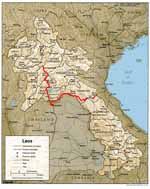
Laos Map
|
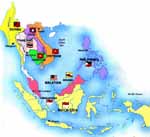
Map of Southeast Asia |
click a picture
to see details |

|
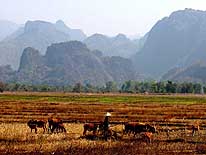
|
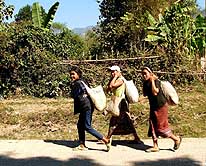
|
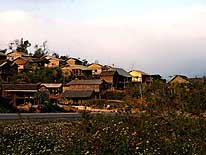
|
- A Farmer is herding the cattle
- on a harvested rice field
|
- Girls are carrying heavy
- loads with a head band
|
- The first mountain village after the Cau Treo
- border crossing with its wooden stilt houses
|
-
- The customs building at the Cau Treo border crossing into Laos is hidden nearly entirely
by a thick wall of fog, when we arrive from Vinh/Vietnam in the early afternoon of January
24th, 2006, and make our way in the rain to the immigration. All the doors are open and a
chilly wind blows through the inhospitable waiting hall. We sit shivering on a bench and
wait for the responsible officer to appear behind his counter to issue our entry visa,
which is obtainable directly at most of the Laotian borders at a cost of US$30. Not having
to apply in advance makes it so easy, but the big disadvantage is that it is valid only
for two weeks, which for us unfortunately showed to be too short. Contrary to all
predictions, our passports and Carnet de Passages are stamped with any signs of corruption
straight forward. And it is also pleasant that nobody wants to know what we carry along in
our car.
-
|

|

|
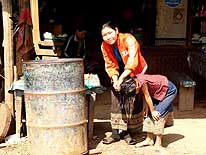
|
- Happy children in front of
- a village grocery store
|
- Woman cooking on her balcony
|
- Most of the daily activities
- take place outside
|
-
- As soon as we are leaving the uncomfortable, chilly and moist offices, we dare to cast a
first glimpse at the many dog cages piled up loosely in front of the customs building.
What an immense relief to find out that they are all empty. Normally, they are stuffed
with dogs of whatever race - collected in Laos - on their final trip to Vietnam. Often,
they have to endure incredible heat, without any water and food for entire days and
nights, and their barking and howling must be heartbreaking. The horror stories we heard
later about the “killing, i.e. cooking” methods, we do not even want to mention
– yes, it is incredible what happens to these intelligent and affectionate pets. We
are really happy that we are spared from this emotional sight and that we may start our
journey into Laos carefree.
-
|
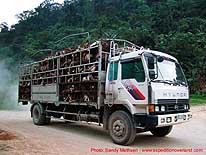
|
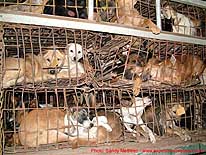
|
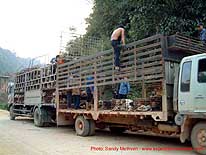
|
| Captured dogs in Laos
on their final trip to Vietnam: |
| A new truckload is
arriving ….. |
- ….. with the deplorable creatures –
- without any water – in their cages …..
|
- ….. and reloading them at the Laotian
- border for the transport to Vietnam
|
-
- (Though shortly after, as we pull out beside the road for a long deserved snack
consisting of a hot noodle soup to warm us up and a piece of Bologna sausage - I am
luckily too busy with eating to see what Emil observes: A new truck load with Hundreds of
captured dogs is on its way to the border). It is another culture, we know it, but still
we will never manage to understand why animals are treated so terribly and insensibly in
some parts of the world. We asked English fellow travelers Sandy Methven und Michael
Groves (www.expeditionoverland.com) - who were able to shoot some pictures - for the
permission to include them in our story, and they agreed. May be it helps if more and more
people get to know about it, and may be somebody is able to take some steps against this
cruelty.
-
|
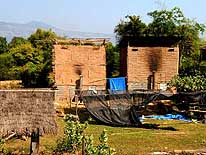
|
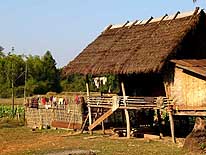
|
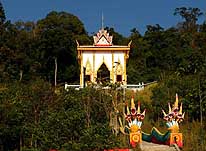
|
- Brickyards along the road
|
- Hut with fenced in garden
- along the Mekong River
|
- A Buddhist temple in the jungle
|
-
- A new country, a new culture, a new feeling! Our first impression of Laos is: “It
looks very much like Nepal”! Just as we remember from the Himalayan nation, we see
also here young boys carrying heavy loads with their head-band and girls buckling on their
backs baskets full of wood and walking bent along the road. The highway, which we follow
from the border is very new, paved just recently, but it remains deserted. After the
crowded and polluted streets in Vietnam and the endless plains, the loneliness and the
stunning view of the mountain scenery comes as a breath of fresh air. And suddenly also
the fog is lifting and we spot a promising shimmer of clear sky on the horizon. Yes, and
next, the sun we missed for such a long time so much, welcomes us. We feel like new-born.
-
|
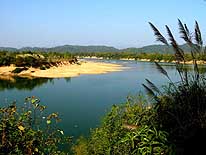
|

|
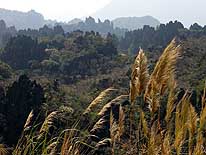
|
- At the confluence of the Mekong
- and Nam Kading River in Pak Kading
|
- Reeds and sandbanks in Pak Kading
|
- View from Saga view point to the
- karsts scenery on Route 8 West
|
-
- The untouched nature and its emptiness – Laos has only 1/10 of Vietnam’s
population – give us this wonderful feeling of space and freedom again. After the
many weeks of practically “never-being-alone” we also nearly forgot, how
relaxing and beautiful solitude can be. When we meet some of the weather-beaten faces of
the mountain people, they look at us only shyly and from a distance, in sharp contrast to
the Vietnamese, who are more curious and always ready for a friendly closeness. Being
privacy loving Europeans, it is an appreciated change. And all at once, both of us feel a
desire to camp out in the nature again – lovely wild camping spots are easy to find.
But unfortunately, my broken leg from Cambodia does not allow it yet. Instead, we sleep
the first night of our 153rd country (as also the following nights) forcibly again in a
bed – in the Souriya Guesthouse in Lak Sao, the first small village after the border.
The basement room is small and cold and the blanket thin, and only our own warm bedding
bought in Amritsar/India allows us to spend the night warm enough. Slowly but steadily, we
start to hate the “four impersonal walls”, on which we are depending since
Cambodia and which start to give us a sense of claustrophobia.
-
|
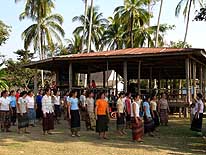
|
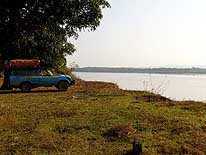
|
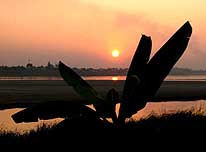
|
- Women are practicing a dance
- at the Mekong River shore
|
- Enjoying the Mekong River
|
- Sunset at the Mekong River in Vientiane
|
-
- Next morning, we are awakened by the lovely songs of birds and the sun is laughing from
a blue sky. The grandiose feeling of space is back immediately again as we drive on a good
tarmac road on Route 8 towards the Mekong River. There is still hardly any traffic and we
enjoy the stunning karst scenery and the quaint villages clinging to the mountain slopes
with huts made from palm leafs and wood, many on stilts. It is like traveling back in
time. Pigs are crossing the street followed by their squeaking youngsters, chicken cackle
nervously and children play joyfully on the road. Tiny, well cultivated vegetable gardens
are attached to many dwellings, fenced in with bamboo against the roaming domestic
animals. There is no garbage lying around. Every inch is swept clean with brooms made out
of reed, which grows on almost every hill. It is cut and collected by half of the
population – young and old, mostly females – and laid out along the road to dry.
The seed is either pounded or rolled off. The drying process is not only taking place on a
small scale. Occasionally we see it for miles along the road all over the country. We just
wonder who is going to buy them all, as they are made by the thousands.
-
|
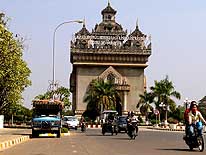
|
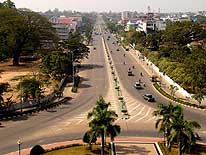
|
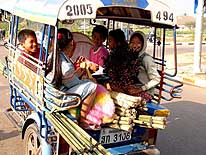
|
- The ‚Patuxai’ in Vientiane,
- the Laotian replica of the
- French ‚Arc de Triomphe’ in Paris
|
- View from ‚Patuxai’
- (Victory Monument) in Vientiane
|
- Children on their way to the market
|
-
- We cross farmers herding their livestock on the harvested rice fields, as they have done
it for decades. This rural live and untouched nature are so peaceful and we enjoy it so
intensively, that - for my taste - we arrive much too soon in Vientiane, the capital of
Laos, where we are re-surrounded by the noisy traffic. We enter the city through the
impressive Patuxai, the Victory Monument – a replica of the ‘Arc de
Triomphe’ in Paris – and head straight to the mighty Mekong, where the river
front is lined with hotels and restaurants - so many, that there is not one gap where we
can pull out with our car, except along the road. Apart from my depressing immobility, it
could have been just this unexpected disillusionment that shortly afterwards - all of a
sudden - I feel a deep anger and discontent, which I focus on Emil straight away. I start
to complain strongly that I am fed up of all the big cities we recently had to visit and
that I would rather prefer to be out in the nature. One word leads to another and a few
minutes later, just when ‘Pha That Luang’ - Laos’ National Symbol and most
important religious monument – also called the ‘Great Sacred Stupa’ –
appears with its spires glistening like gold in the warm evening light, I already begin to
regret my uncontrolled outburst. But it is unfortunately too late – the “fire is
already burning in the roof”, as we are saying.
-
|
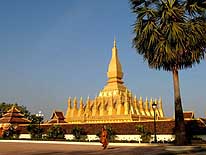
|
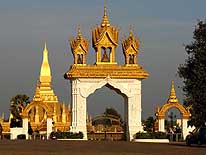
|
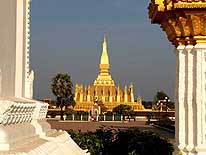
|
| ‚Phat That
Luang’, called also ‚Great Sacred Stupa’ in Vientiane |
- ….. is Laos’ National symbol and the
- most important religious monument .….
|
- ..... and its impressive gate .....
|
- ..... and its breathtaking „golden“ appearance
|
-
- Emil is so mad at me about my - according to him - unjustified fury that he remains
stubbornly seated in the car and leaves me hopping away alone with my crutch and the
camera to this breathtakingly beautiful sight (yes, occasionally this can happen also in
our family!). I do not make it further than to the entrance, where I sit down exhausted on
the stone steps to absorb the serenity of this “golden” picture. But it does not
take long and Emil is on my side again. Sharing a moment of joy make fade away problems
very soon. That is what happens also here and soon our arguing belongs to the past. Later
in the evening, when we are sitting at a small table of a highly pregnant woman at the
riverside, sipping an ice cold BeerLao, watching the Mekong pass by and the sunset
inflaming the sky, full peace and harmony has returned to us.
-
|
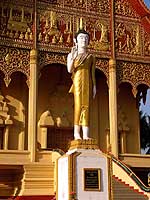
|
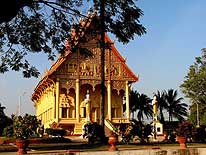
|
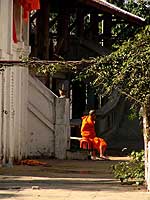
|
- Buddha image in one of the remaining
- two of originally four temples
- surrounding ‚Pha That Luang’
|
- One of the two remaining
- temples still surrounding ‚Pha
- That Luang“; once there were four
|
- A Buddhist monk in a temple garden
|
-
- Two days of busy city life while I am more or less restrained to the car, is long
enough. Towards noon, we are heading North to Vang Vieng – a village described in our
guide book as “either you love it or you hate it”. Our feelings for this place
are somewhere in between, surely also influenced by the fact that practically the whole
village looks like one construction site. All the roads are dug up due to the improvement
of the sewage system, what does not look very inspiring. What we like though is its
beautiful setting, nestling between the Nam Song River and the stunningly beautiful
limestone karst scenery; but also the many cozy restaurants, where sitting on soft
cushions on low tables is wonderfully relaxing. Yes, everything sounds so exciting, if
only the “IF” would not be.
-
|

|
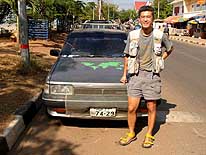
|
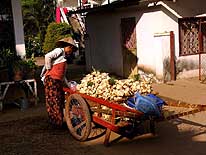
|
- „Our“ pregnant mother with her
- street stall at the Mekong River
|
- Encounter in Vientiane with Taff
- (Yamazaki Tatsuya), a Japanese
- world traveler, who visited already
- 98 countries in a 1986 Toyota Carina
|
- Hand cart vendor in Vientiane
|
-
- The huge popularity of Vang Vieng is unfortunately not only originating from its
wonderful setting and the possibilities of exploring limestone caves, kayaking and tubing
on the river on tractor inner tubes. Where “happy meals” are served, i.e.
pizzas, milkshakes etc. enriched with “stuff”, it does not need much fantasy to
find out what the “genuine” specialty is what attracts hundreds of
“hangers”. In this unmistaken drug scene we definitely are at the wrong place.
At least we find a lovely spot on the river shore, where we spend the evening hours
relaxing, watching the people floating down the river and the sun disappear on the other
side. Then, we return to our quiet room in the Chaleun Vieng Phone Guesthouse. For only
US$4 a room, there is besides air-conditioning even hot water and in the morning fresh
coffee.
-
|

|

|
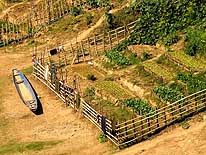
|
- Cultivated fields in a valley
|
- The blue band of a river
- winding through the plains
|
- Vegetable garden and a boat
- along the river shore
|
-
- Next morning, the waking up call is already very early. Our plan is to reach Luang
Prabang, 220 kilometers to the North at the confluence of the Mekong and the Nam Khan
River, for which we count with a 7-hours drive through the mountains. The village life is
just slowly awakening, when we leave behind us the karsts valley of Vang Vieng. The first
attraction is not far away. Already at the next river crossing, we are rewarded for our
early start with a wonderful view: Bizarre mountain peaks and some lonely houses are
reflecting in the motionless dark surface of the river. With anticipated joy, we continue
towards the magnificent mountain scenery luring in the distance, only to be disappointed
shortly afterwards when all of a sudden, we are surrounded by dense fog which conceals all
the mountains beauties. Even down in the valley mist is moving in patches over the
harvested rice fields.
-
|
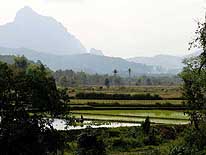
|
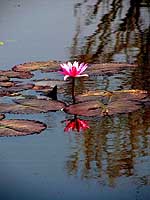
|
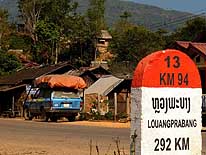
|
- View over rice fields and mountains
- between Vang Vieng and Vientiane
|
- Water lily reflecting in
- the motionless water
|
- Still 181 miles to go to Luang Prabang
|
-
- While the sun reappears, the road starts to climb higher and higher, twisting up and
down, until we reach the top at 4’000 ft. Now and then, we cross small villages
snuggling amongst green mountain ridges, where naked or half-naked children are running to
the side of the road as we pass. They are smiling brightly and screaming joyfully
“sabaai-dii”, which means “Hallo”. Women are washing clothes and
scrubbing their children in a river. Their husbands mostly sit lazily in front of the
simple huts, chatting and smoking whatever grass. After a sharp bend, we are surprised to
see a group of very young soldiers with guns sitting on a shady spot on the pavement. What
are they doing here? Why are they here? We are not so sure what we should think about
them. Automatically, we recall what we just recently read in our guide book: That exactly
on this remote mountain stretch, until 2004 Hhmong rebels were still active and killed
eight people of a passing local bus, including two Western cyclists who just happened to
come along.
-
|
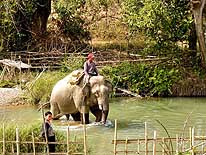
|
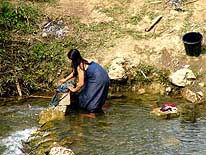
|
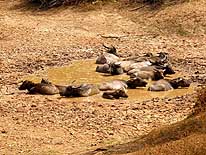
|
- Working elephant and
- mahout cooling down
|
- Laundry in the river
|
- Water buffalos having
- fun wallowing in the mud
|
-
- But there are no incidences and mid afternoon, we arrive safely in Luang Prabang, where
we are greeted by the mighty Mekong River again. With its many wide-branched trees and
high coconut palms skirting the narrow alleys, it is so green that we can hardly believe
we are in a city. This greenery, combined with its many beautiful temples, adds to the
unique charm of quietness and loveliness surrounding this UNESCO world heritage site. But
soon we discover also the seamy side - the significant flow of tourists overrunning the
place. In the main street and along the Mekong promenade there is an endless flow of
foreigners, and it is inevitable to run into each other again and again. We cannot count
with how many traveling enthusiasts we have spoken. Mostly we are approached as soon as we
park. But in sharp contrast to the drug related “hangers” in Vang Vieng, these
are common tourists, interested in what is happening around them.
-
|
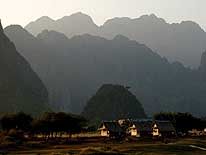
|
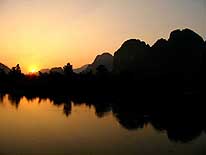
|
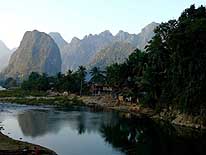
|
- The wonderful karsts
- scenery in Vang Vieng
|
- The sun sets across the
- Nam Song River in Vang Vieng
|
- Mountains and houses reflecting wonderfully
- on the river crossing after Vang Vieng
|
-
- One party follows the other and it happens a couple of times, that we are still
answering patiently questions at dusk, realizing too late that we missed again another of
the always spectacular sunsets. But, of course, we enjoy also talking to so many different
people, some of them really remarkable travelers too: One of them is the Frenchman Robert
Teissier from the island of La Réunion in the Indian Ocean, who invites us spontaneously
to his island. Then the Chinese, who firmly insists that in China also a foreign car is
allowed to travel around freely and absolutely does not want to accept the contrary. Then
the 68 years old German, who complains how difficult it is nowadays in Europe to find a
partner of the opposite sex sharing the same desire to travel the world and who is also
very well informed that two hours of sex cost here around US$ 25-30.
-
|
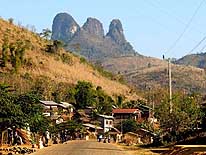
|
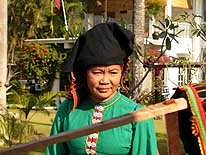
|
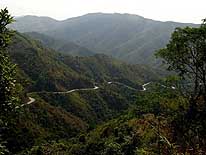
|
- A small mountain village along the road
|
- Heading for Luang Prabang’s market
|
- Remote mountain road from
- Vang Vieng to Luang Prabang
|
-
- One day, we are also approached by a Swiss couple from Berne, touring Thailand and Laos
by bicycle in seven weeks. At some point, we start also to talk about my “Christmas
gift” from Cambodia - my broken leg. When they look at my second cast from Hanoi, I
am really shocked to hear the wife saying to her husband worriedly: “The cast is put
on in a wrong angle, isn’t it?” When I look at them in disbelieve, she quickly
explains: “Well, we are both doctors”. “What does that mean specifically
for me”, I dare to ask. “The Achilles tendon might have shrunk what means that
the leg’s back might be slightly shorter now”. Probably I looked so dismayed
that the husband hurries to add: “Don’t worry – it will heal again, it just
might take a bit longer and can also cause some pain. And may be at the beginning you will
have to walk with a shoe with a high heel” Luckily by then I did not know how right
they were!
-
|
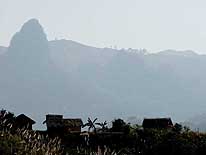
|

|
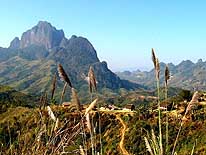
|
- A few 'lost' houses on a mountain
- ridge on 4’000 ft. altitude
|
- White wild flowering bushes
|
- A tiny village in its bizarre surrounding
|
-
- Beautiful exotic temples are everywhere in Luang Prabang – apparently more than 30.
Despite that our initial enthusiasm for them has faded a little bit away, having seen so
many recently, we at least want to visit the ‚Wat Xieng Thong’, said to be the
most magnificent one. As I hop with my crutch slowly towards the monk to pay my entry fee
of US$1, which is applicable almost to every major temple of Luang Prabang, he looks at me
compassionately and does not want to accept any money. It is the first positive sign of my
accident! We are really impressed by all the elaborate mosaic tiles decorating the walls,
depicting the tree of life and scenes of every days life – something, we have not
seen before. While Emil is exploring the area more closely, taking many pictures, I enjoy
simply sitting on a stone bench under a shady tree, appreciating the peaceful oases –
a feeling I have had so far in every temple garden.
-
|
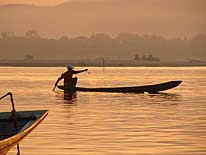
|
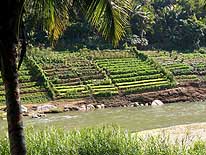
|
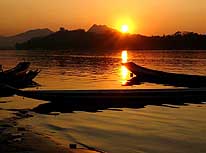
|
- A fisherman at sunset at the
- Mekong River in Luang Prabang
|
- Well tended gardens along the river
|
- One of the many magnificent sunsets
- at the Mekong River in Luang Prabang
|
-
- The golden Stupa on a hill, visible practically from every part of the city, looks too
tempting to miss it. It is ‘That Chomsi” on ‘Phu Si’ hill, reachable
through 330 steep steps – again something for Emil only. When he returns drenched in
sweat, but with a cheerful face, I know that it was worth it. Looking at the exotic
pictures, I am annoyed once more for what I just missed again. The temple itself is not as
beautiful; but the view over the town and especially also over the night market, which is
built up every single day at the same time from the same vendors and with the same
patience. It is packed with silks, handicrafts, jewellery and clothing and looks very
colorful. Especially the woven blankets are attractive. Emil argues tough that most
probably the stuff comes from China and is not (anymore) produced locally. I am not so
sure about it. All good things being three, we visit also ‘Wat Pa Pon Phao’,
lying on a hill about 2 miles outside of the town and reachable by car. Especially lovely
is the view of the just opposite lying ‘That Chomsi’. A monk novice and a nun,
who chews endlessly ‘Betelnut”, showing her red teeth when laughing, keep us
company. But as it has been also in many other places, it unfortunately remains a
superficial encounter due to language barriers.
-
|
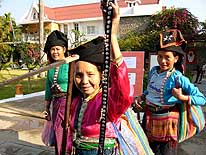
|

|
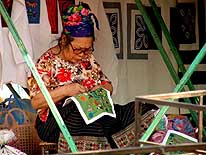
|
- Souvenir sellers in Luang Prabang
|
- The colorful night market in
- Luang Prabang viewed from ‚Phu Si’ hill
|
- Making new embroidery for tourists
- at Luan Prabang’s market
|
-
- In the Suan Phao Guesthouse (near the Le Parasol Blanc Hotel) we rent a small bungalow
with a balcony in a lovely garden for US$7. We feel so happy in our peaceful oasis which
lies on a small river, that we postpone our return to Vientiane day by day. It is so
relaxing to be surrounded by high coconut palms, exotic trees and flowering bushes. Very
often we sit on our tiny veranda – for breakfast, for lunch, with our laptop, with a
book, talking or simply enjoying the songs of the birds and the bright butterflies
fluttering from flower to flower. Time flies and soon from one day become two, then four,
then eight. But then, we have definitely to say good bye for visa reasons. On our
departure morning, we set our alarm clock at 5am, not only because of the 7 hours drive
back to Vang Vieng, but especially also, because we would like to experience at least
once, when at dawn the Buddhist monks in their shiny saffron robes are on their alms-round
with a bowl in their hand.
-
|

|
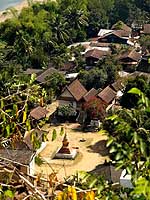
|
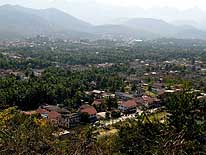
|
| View from ‚Phu
Si’ hill over: |
- ..... a temple area .....
|
- ..... a Stupa .....
|
- ..... and green Luang Prabang
|
-
- We never have encountered the western fascination for the eastern way of life in such a
disturbing way as on this morning in the streets of Luang Prabang. A concentration of
Western tourists, fully equipped with cameras, has gathered to witness curiously this
daily practiced devotion, for which we have in a way full understanding, because we have
the same fascination for a foreign culture. But what we find extremely upsetting is that
in their attempt to capture this colorful scene from as close as possible, they often
forget the rules of politeness and behavior, and therefore hurt the feelings of the monks.
We would not have been surprised at all, if some of them had even stumbled over the monks.
How very useful are in such cases the tele lenses!
-
|
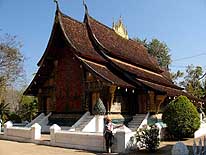
|
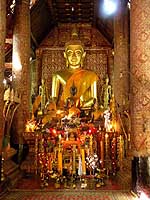
|
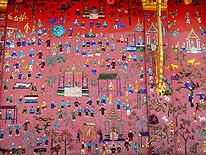
|
- ‚Wat Xieng Thong’ is the most
- magnificent temple of Luang Prabang
|
- ..... its golden Buddhas .....
|
- ..... and its intricate mosaic tiles
- adorning the walls
|
-
- The daily morning market with its richly displayed variety of vegetables, fruits and
meat is already in full swing when we leave Luang Prabang behind us with a supply of
delicious chocolate cake and two fresh crispy baguettes, which are sold at many corners.
We follow the same mountainous and windy road towards Vientiane, with the same potholes
and the same terrible bumps, but also with the same magnificent mountain scenery. This
time, the villages we pass are surprisingly nearly lifeless – we miss the hearty
laughs of the people gathering outside their huts and the children greeting us joyfully.
Today is a Sunday - may be that this is the reason?
-
|
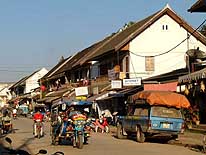
|
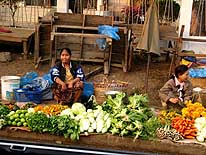
|
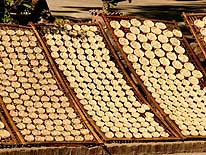
|
- The main street of Luang Prabang
- shows provincial character
|
- Morning market in Luang Prabang
|
- Put on a rack to dry
|
-
- Everything is just running smoothly under a blue sky; our LandCruiser takes easily the
steepest parts in the second gear and we enjoy for the second time this most beautiful
mountain ride we did in Indochina. Even an elephant, which cools down with its mahout in a
waterhole, delights us along the road. The only thing we miss again is a suitable spot to
pull out for a relaxing lunch break. At some point, when our stomach is rumbling
precariously, we decide to park right on the side of the road, the traffic being weak
anyway. It is not a bad idea at all: A mountain peak offers us the most appreciated shadow
along a nice creek. Passing many cabbage fields, which are still watered the old fashioned
way with cans, we finally reach Vang Vieng mid afternoon and the next day we are back in
Vientiane. Coming back for the second time to the same place is always a bit like
returning home. Everything is so familiar: The supermarket, where we stock up again with
expensive cheese, ham and butter; “our” pregnant mama, who serves a few tables
along the river with food and beverages from her street kitchen and looks really happy to
see us again; the Mekong, where the sand banks became bigger und the water less in the
meantime; and last but not least, the unforgettable sunsets.
-
|
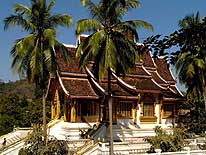
|
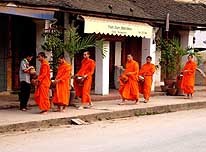
|
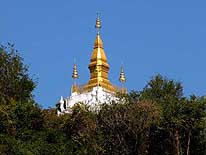
|
- View from ‚Phu Si’ hill over
- ‚Sala Pha Bang’ of the Royal Palace
|
- Buddhist monks collecting alms at
- dawn in the streets of Luang Prabang
|
- The golden ‚That Chomsi’ Stupa on
- ‚Phu Si’ hill is visible from almost everywhere
|
-
- A soft evening breeze is cooling wonderfully on the eve of our departure. We sit again
at the romantic Mekong River – of course sipping a BeerLao - and are already
melancholic that our journey in Laos will come to an end tomorrow. By chance we get
interesting company from Jacqueline and Ivo from Winterthur in Switzerland. They are
touring the world since nine months with a motorbike. As around 9pm we return to our
LandCruiser, we find a short note under the wind screen from Taff – a Japanese with
the name of Yamazaki Tatsuya, on the road since July 1994 with a Toyota Carina, year 1986.
He has already visited 98 countries. We have hardly finished reading his message, when he
shows up. It is only the second time in our 21 years of travels that we meet a Japanese
guy traveling alone; the first time was in South America. Of course, there is a lot of
common ground to talk about. What we are particularly interested in is Myanmar, which
country he already accomplished with his car while we are still working on it. And he is
especially eager to get more information about Vietnam, his next goal, where we have
already been successful. (Unfortunately, he did not get a permit because his Japanese car
is right hand driven).
-
|
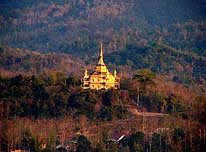
|
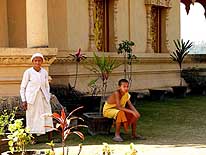
|
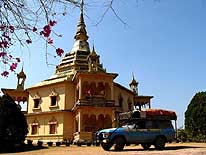
|
- Temple glistening like pure gold in the
- dry surroundings of Luang Prabang
|
- A monk novice and a nun keep
- us company at ‚Wat Pa Phon Phao’
|
- ‚Wat Pa Phon Phao’ lies around
- two miles outside Luang Prabang
|
-
- Before we return „home“ to our guesthouse, we take a last look at the mighty
Mekong River. There have always been these little “wonders” giving us so much
enjoyment in our journey around the world – a sunset, which in its beauty is hard to
describe – an elephant trotting unexpectedly along the road – a performance of
birds waking us up in the morning or a reed covered hill, glistening like silver. With all
these precious memories, we leave Laos next day over the friendship bridge into Thailand.
-
|
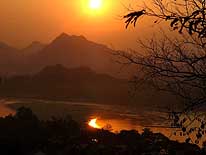
|
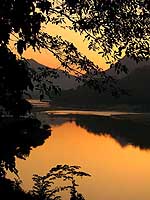
|
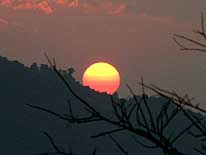
|
| Farewell from the
mighty Mekong River and from beautiful Laos |
-
|
![]()










































































